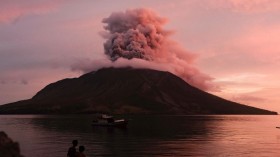An international team of scientists have found a massive magmatic lake, about the same mass as some of the world's largest freshwater lake, hidden 15 kilometers beneath a dormant volcano in Bolivia, South America.
The lake, described in a paper published in the journal Earth and Planetary Science Letters, is dissolved into a partially molten rock at a temperature of almost 1,000 degrees Celsius. The lake was found below the Cerro Uturuncu volcano in the Bolivian Altiplano.
"The Bolivian Altiplano has been the site of extensive volcanism over past 10 million years, although there are no currently active volcanoes there. The Altiplano is underlain by a large geophysical anomaly at depths of 15 km below the surface of the earth, said Jon Blundy, a professor at University of Bristol's School of Earth Sciences and part of the research team that discovered the lake, in a press release. "This anomaly has a volume of one-and-a-half million cubic kilometres or more and is characterised by reduced seismic wave speeds and increased electrical conductivity. This indicates the presence of molten rock."
The researchers noted that only about 10 to 20 percent of the partially molten rock is liquid and the rest is solid. By performing high temperature and pressure experiments at the University of Orléans in France, the researchers were able to characterize the partially molten region under the volcano.
The electrical conductivity of the molten rock found in the underground lake suggests that there must be eight to ten percent water dissolved in the silicate melt. The eight to ten percent of water dissolved in the magmatic lake amounts to a total mass of water equivalent to what is found in some of the giant freshwater lakes in North America, such as Lake Superior.
Water can only be dissolved by the silicate melt at high pressure. At low pressure, water comes out of the solution and forms bubble. As it turns out, these bubbles can drive volcanic eruptions.
© 2024 NatureWorldNews.com All rights reserved. Do not reproduce without permission.

![Extreme Heat Wave in Africa’s Sahel Region That Killed 100 People Linked to Climate Change [Study]](https://1471793142.rsc.cdn77.org/data/thumbs/full/70226/280/157/50/40/extreme-heat-wave-in-africa-s-sahel-region-that-killed-100-people-linked-to-climate-change-study.jpg)



